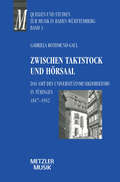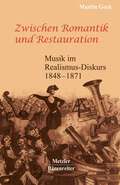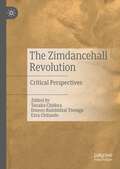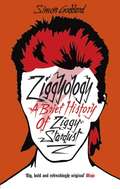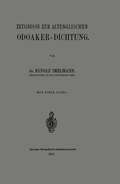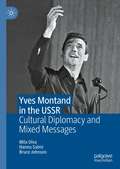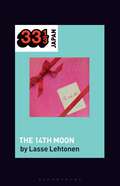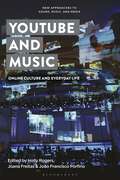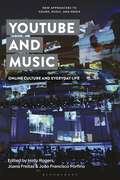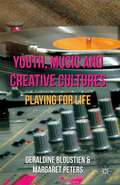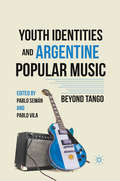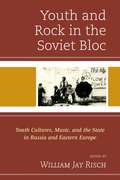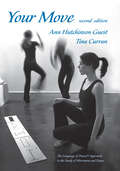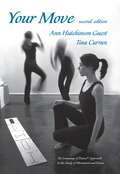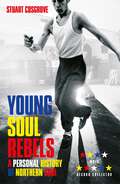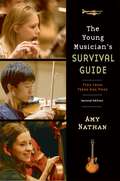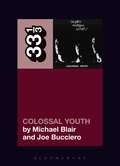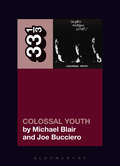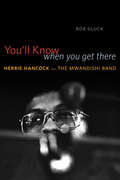- Table View
- List View
Zwischen Taktstock und Hörsaal: Das Amt des Universitätsmusikdirektos in Tübingen 1817-1952
by Gabriela Rothmund-GaulIm traditionellen Fächerkanon der Tübinger Alma Mater war er nicht vorgesehen: der Universitätsmusikdirektor. Doch schon der erste akademische Musiklehrer Friedrich Silcher gestaltete in über 40 Dienstjahren seine Stelle zu einem mit Ansehen und vielfältigsten Pflichten versehenen Amt, das von der Hochschule und aus der Stadt nicht mehr wegzudenken war. Schon bei ihm wurde die der Stelle immanente Polarität deutlich - die Tätigkeit als Praktiker und als Theoretiker -, die erst 1952 zur Trennung von Praxis und Wissenschaft und zur Errichtung eines Lehrstuhls für Musikwissenschaft führte. Auf der Basis ausgiebiger Quellenstudien stellt Rothmund-Gaul unter dem institutionsgeschichtlichen Ansatz das Werden des Faches Musikwissenschaft - exemplifiziert an der Universität Tübingen - dar. Daß unter den Bewerbern viele berühmte Musikwissenschaftler wie Musiker waren, zeigt einerseits, welche Anziehungskraft das Amt eines Universitätsmusikdirektors hatte, und macht andererseits deutlich, wie sehr musikalische Praxis und musikwissenschaftliches Arbeiten noch bis in die Mitte unseres Jahrhunderts verbunden waren.
Zwischen Romantik und Restauration: Musik im Realismus-Diskurs 1848 bis 1871
by Martin GeckRealismus in der Musik? Indem Martin Geck bedeutende Werke von Schumann, Wagner, Berlioz, Liszt, Mahler und Brahms der Epoche des Realismus zuweist, zeichnet er einen spannenden politisch-ästhetischen Diskurs nach. Dabei positioniert er die Meisterwerke der Musik zwischen den Vorwürfen der Selbstverliebtheit einerseits und der Politiksüchtigkeit andererseits. Somit entsteht ein völlig neues Bild der Musikgeschichte des 19. Jahrhunderts.
Zwischen Pastiche Und Zitat: Die Urheberrechtsreform 2021 Und Ihre Konsequenzen Für Die Künstlerische Kreativität (Musik Und Klangkultur Ser. #58)
by Frédéric DöhlDie Urheberrechtsreform 2021 und ihre Konsequenzen für die künstlerische Kreativität Künstlerisches Schaffen hat stets einen signifikanten Bearbeitungsanteil, nicht nur da, wo es um Transformationen fremder Werke geht. Werke Dritter inspirieren das eigene Schaffen und hinterlassen Spuren darin. Hier entstehen Konflikte um ökonomisches, kulturelles und soziales Kapital. Das Urheberrecht versucht diese zu moderieren und zu regulieren. Die rechtlichen Bedingungen, unter denen in Deutschland geschützte künstlerische Arbeiten Dritter erlaubnisfrei in eigenen neuen künstlerischen Werken verwendet werden dürfen, haben sich seit 2019 radikal gewandelt. Frédéric Döhl bewertet den neu erreichten Stand des Bearbeitungsrechts aus Sicht der künstlerischen Theorie und Praxis. Mit seinem Fokus auf fremdreferenzielles Komponieren schließt er an sein Buch »Mashup in der Musik« (2016) an, dessen rechts- und kulturpolitische Position sich nun mit einer Lebens- und Rechtswirklichkeit konfrontiert sieht, die sich – so die Kernthese der neuen Analysen – kategorial geändert hat.
Zwischen bürgerlicher Identität und musikalischer Profession: Die Geschichte der Philharmonischen Gesellschaft Bremen im 19. Jahrhundert (Musik und Klangkultur #53)
by Katrin Bock1825 geschieht in Bremen etwas Erstaunliches: In der Hansestadt schließt sich ein kleiner Kreis des Stadtbürgertums zusammen, um ein professionelles Orchester zu gründen. Es entsteht der Verein für Privat-Concerte - u. a. Vorgänger der heutigen Bremer Philharmoniker. Unter welchen sozialen und städtischen Voraussetzungen fand die Vereinsgründung statt? Wer war beteiligt und welche musikalischen Institutionen standen in Wechselwirkung zum Privat-Concert? Katrin Bock stellt die Konzertdirektoren und Dirigenten vor und fragt nach dem »hanseatischen Geschmack«.
The Zimdancehall Revolution: Critical Perspectives
by Tanaka Chidora Doreen Rumbidzai Tivenga Ezra ChitandoZimdancehall is a musical movement in Zimbabwe that has grown significantly since 2010. The Zimdancehall Revolution brings together critical essays on various aspects of Zimdancehall culture by scholars from diverse disciplines. Traditionally, music critics and senior academics have not taken Zimdancehall seriously, regarding it as vulgar, transient, bubble gum, lacking depth, and in short, a fad. There were also allegations that the lyrics influenced factionalism, incited violence and glorified drug use and unbridled promiscuity among the youth. This book affords this movement the protracted intellectual engagement that it deserves and argues that Zimdancehall is more than just a musical genre but an everyday culture, a way of life. The genre’s close association with the ghetto is telling and enables critics to look at it as a social movement, a revolution, or a raw, petulant and raging disturbance of peace by those who live their lives on the margins. It is, thus, a violent irruption onto the public space by marginalised young people whose presence as artistes creating art from the margins, simultaneously as victims and agents, circulating in a geography that escapes the limits of nationalist ideological and physical territory, in a way subverts communitarian prescriptions and allows young people entry into the world, albeit in a painful, tumultuous and violent way. The essays range from the mapping of the genre’s historical development to theoretical interventions in understanding the genre and its relationship with various aspects of the Zimbabwean society like politics, gender, religion, language, dance, cultural values and other genres.
Ziggyology: A Brief History Of Ziggy Stardust
by Simon GoddardHe came from Outer Space...It was the greatest invention in the history of pop music – the rock god who came from the stars – which struck a young David Bowie like a lightning bolt from the heavens. When Ziggy the glam alien messiah fell to Earth, he transformed Bowie from a prodigy to a superstar who changed the face of music forever. But who was Ziggy Stardust? And where did he really come from?In a work of supreme pop archaeology, Simon Goddard unearths every influence that brought Ziggy to life – from HG Wells to Holst, Kabuki to Kubrick, and Elvis to Iggy. Ziggyology documents the epic drama of the Starman’s short but eventful time on Planet Earth… and why Bowie eventually had to kill him.
Zayn: The Official Autobiography
by Zayn***NOMINATED FOR THE NME BEST BOOK AWARD 2017 *** The first and only OFFICIAL book from ZAYN, for his ultimate fans. Zayn's autobiography features exclusive, never-before-seen photographs alongside his story. -------------------------------- 'This book is my diary of a period that I would like to share with you all. I hope that there are things in the book that contextualise some of the moments and memories we have all shared together. There are things I address in the book that are very personal to me, things that I have never told anyone, things I still find hard to talk about. It's a part of a journey I'm still on' - ZAYN ZAYN opens up with this collection of thoughts, inspiration, and never-before-seen personal photographs. After five years of massive success with One Direction, ZAYN launched his career as a solo artist with Mind of Mine, becoming one of the most successful artists in the world. Now, for the first time ever, ZAYN is going to tell and show all in this intimate and raw scrapbook of his life. Never-before-released photos give readers insight to ZAYN, no-holds-barred. Gorgeously designed with hundreds of full-color photographs and Zayn's notes, drawings, song lyrics, and personal stories, the book captures Zayn's most private moments and his candid feelings on fame, success, music, and life. The next chapter of ZAYN'S evolution into global superstar, told by the artist who is living it. Global superstar ZAYN shares a photographic journey of his life since leaving One Direction. *** Reviews for Mind of Mine: "A singer eager to reclaim the parts of himself that five years in the pop klieg lights forced into the shadows." -The New York Times "Sonically, you won't find many pop albums in 2016 more immaculately conceived than this." -SPIN "Sublime." -USA Today "Malik can sing . . . he's done this before, but not like this." -Rolling Stone "A moody, deeply textured R&B album..." -Los Angeles Times "Zayn has clearly achieved his aim of making an album of sexy, credible pop-R&B." -NME
Yves Montand in the USSR: Cultural Diplomacy and Mixed Messages
by Mila Oiva Hannu Salmi Bruce JohnsonThis volume is the first book-length account of Yves Montand’s controversial tour of the Soviet Union at the turn of the years 1956/57. It traces the mixed messages of this internationally visible act of cultural diplomacy in the middle of the turbulent Cold War. It also provides an account of the celebrated French singer-actor’s controversial career, his dedication to music and to peace activism, as well as his widespread fandom in the USSR. The book describes the political background for the events of the year 1956, including the changing Soviet atmosphere after Stalin’s death, portrays the rising transnational stardom of Montand in the 1940s and 1950s, and explores the controversies aroused by his plan to visit Moscow after the Hungarian Uprising. The book pays particular attention to Montand’s reception in the USSR and his concert performances, drawing on unique archival material and oral history interviews, and analyses the documentary Yves Montand Sings (1957) released immediately after his visit.
Yuming's The 14th Moon (33 1/3 Japan)
by Lasse LehtonenIt is not an exaggeration that Matsutoya Yumi-better known by her stage name Yuming-is one of the most influential figures in Japanese popular music history. A singer-songwriter recognized globally for her songs used in Miyazaki Hayao's beloved animations, Yuming has captured the hearts of listeners of different generations since her debut in the early 1970s. Her fourth album, The 14th Moon, released in 1976, was a milestone in establishing her signature style: the posh, “city” sound that later paved the way to the 1980s City Pop and 1990s J-pop. In addition to examining the album's astonishing stylistic versatility, this book explores how Yuming revolutionized the position of women in Japanese popular music and how her work can help us understand social changes in Japan of the 1970s.
Yuming's The 14th Moon (33 1/3 Japan)
by Lasse LehtonenIt is not an exaggeration that Matsutoya Yumi-better known by her stage name Yuming-is one of the most influential figures in Japanese popular music history. A singer-songwriter recognized globally for her songs used in Miyazaki Hayao's beloved animations, Yuming has captured the hearts of listeners of different generations since her debut in the early 1970s. Her fourth album, The 14th Moon, released in 1976, was a milestone in establishing her signature style: the posh, “city” sound that later paved the way to the 1980s City Pop and 1990s J-pop. In addition to examining the album's astonishing stylistic versatility, this book explores how Yuming revolutionized the position of women in Japanese popular music and how her work can help us understand social changes in Japan of the 1970s.
You've Got This: And Other Things I Wish I Had Known
by Louise RedknappIn more than two decades in the limelight, Louise Redknapp has weathered her fair share of ups and downs, but through it all she's remained unapologetically true to herself.From dancing in her bedroom as a young girl with big dreams to getting a scholarship to Italia Conti and experiencing her first taste of musical success with Eternal, to navigating fertility struggles, motherhood and rediscovering her passion for performing, in You've Got This Louise offers a refreshingly honest perspective on the experiences that have shaped her.Warm, funny and wise - like a chat with a close friend - this empowering and uplifting guide weaves together Louise's personal stories and poignant observations on life to gently reassure and encourage, while providing tips and advice on how to get the most out of life by embracing positivity.Brimming with insight on falling back in love with yourself, managing expectations, overcoming critics, dealing with social media and trusting your instincts as a parent, this is Louise's powerful love letter to anyone who has ever wondered if they're getting it right: you've got this.
YouTube and Music: Online Culture and Everyday Life (New Approaches to Sound, Music, and Media)
by Holly Rogers, Joana Freitas and João Francisco PorfírioYouTube has afforded new ways of documenting, performing and circulating musical creativity. This first sustained exploration of YouTube and music shows how record companies, musicians and amateur users have embraced YouTube's potential to promote artists, stage performances, build artistic (cyber)identity, initiate interactive composition, refresh music pedagogy, perform fandom, influence musical tourism and soundtrack our everyday lives. Speaking from a variety of perspectives, musicologists, film scholars, philosophers, new media theorists, cultural geographers and psychologists use case studies to situate YouTube as a vital component of contemporary musical culture. This book works together with its companion text Remediating Sound: Repeatable Culture, YouTube and Music.The ebook editions of this book are available open access under a CC BY-NC-ND 4.0 licence on bloomsburycollections.com. Open access was funded by Knowledge Unlatched.
YouTube and Music: Online Culture and Everyday Life (New Approaches to Sound, Music, and Media)
YouTube has afforded new ways of documenting, performing and circulating musical creativity. This first sustained exploration of YouTube and music shows how record companies, musicians and amateur users have embraced YouTube's potential to promote artists, stage performances, build artistic (cyber)identity, initiate interactive composition, refresh music pedagogy, perform fandom, influence musical tourism and soundtrack our everyday lives. Speaking from a variety of perspectives, musicologists, film scholars, philosophers, new media theorists, cultural geographers and psychologists use case studies to situate YouTube as a vital component of contemporary musical culture. This book works together with its companion text Remediating Sound: Repeatable Culture, YouTube and Music.
Youth, Music and Creative Cultures: Playing for Life
by Geraldine Bloustien Margaret PetersThis book offers an evocative cross-cultural exploration into the everyday lives and music practices of young people from their own broad social, cultural and ethnic perspectives. Youth from seven urban locales in Australia, the UK, the US and Europe document and reflect on their own learning processes and music activities.
Youth Identities and Argentine Popular Music: Beyond Tango
by Pablo Semán and Pablo VilaThis book analyzes the music that young porteñas/os (the inhabitants of Buenos Aires, Argentina) actually listen to nowadays, which, contrary to well-entrenched stereotypes, is not tango but rock nacional, cumbiaand romantic music. Chapters examine the music and what the Argentinean youth use it to say about themselves.
Youth And Rock In The Soviet Bloc (PDF): Youth Cultures, Music, And The State In Russia And Eastern Europe
by Zhuk Risch Christopher Ward Sergei Zhuk Polly McMichael Gleb Tsipursky Tom Junes Jonathyne Briggs Kate Gerrard Sandor Horvath Gregory Kveberg William Risch David Tompkins Dean VuleticYouth and Rock in the Soviet Bloc explores the rise of youth as consumers of popular culture and the globalization of popular music in Russia and Eastern Europe. This collection of essays challenges assumptions that Communist leaders and Western-influenced youth cultures were inimically hostile to one another. While initially banning Western cultural trends like jazz and rock-and-roll, Communist leaders accommodated elements of rock and pop music to develop their own socialist popular music. They promoted organized forms of leisure to turn young people away from excesses of style perceived to be Western. Popular song and officially sponsored rock and pop bands formed a socialist beat that young people listened and danced to. Young people attracted to the music and subcultures of the capitalist West still shared the values and behaviors of their peers in Communist youth organizations. Despite problems providing youth with consumer goods, leaders of Soviet bloc states fostered a socialist alternative to the modernity the capitalist West promised. Underground rock musicians thus shared assumptions about culture that Communist leaders had instilled. Still, competing with influences from the capitalist West had its limits. State-sponsored rock festivals and rock bands encouraged a spirit of rebellion among young people. Official perceptions of what constituted culture limited options for accommodating rock and pop music and Western youth cultures. Youth countercultures that originated in the capitalist West, like hippies and punks, challenged the legitimacy of Communist youth organizations and their sponsors. Government media and police organs wound up creating oppositional identities among youth gangs. Failing to provide enough Western cultural goods to provincial cities helped fuel resentment over the Soviet Union's capital, Moscow, and encourage support for breakaway nationalist movements that led to the Soviet Union's collapse in 1991. Despite the Cold War, in both the Soviet bloc and in the capitalist West, political elites responded to perceived threats posed by youth cultures and music in similar manners. Young people participated in a global youth culture while expressing their own local views of the world.
Your Move
by Ann Hutchinson Guest Tina CurranThis second edition of this well-known text book now offers downloadable resources to accompany the dance studies throughout the chapters. The authors take a new approach to teaching, learning and creating with notation through movement exploration, exercises and short dances, thus enlarging the scope of the book to teachers of movement, movement analysis and choreography as well as the traditional dance notation students.Updated and enlarged to reflect the most recent scholarship and through a series of exercises, this book guides students through:movement, stillness, timing, shaping, accentstravellingdirection, flexion and extension,rotations, revolutions and turnssupporting, change of supportspringingbalancerelationships.All of these movements are explored sequentially and are represented symbolically in notation so the student learns how to physically articulate, notate and describe the movements as they are performed.
Your Move
by Ann Hutchinson Guest Tina CurranThis second edition of this well-known text book now offers downloadable resources to accompany the dance studies throughout the chapters. The authors take a new approach to teaching, learning and creating with notation through movement exploration, exercises and short dances, thus enlarging the scope of the book to teachers of movement, movement analysis and choreography as well as the traditional dance notation students.Updated and enlarged to reflect the most recent scholarship and through a series of exercises, this book guides students through:movement, stillness, timing, shaping, accentstravellingdirection, flexion and extension,rotations, revolutions and turnssupporting, change of supportspringingbalancerelationships.All of these movements are explored sequentially and are represented symbolically in notation so the student learns how to physically articulate, notate and describe the movements as they are performed.
Young Soul Rebels: A Personal History of Northern Soul
by Stuart CosgroveNorthern soul is the ultimate underground music scene. Hidden away from the mainstream, it has defied the logic of fashion and outlasted more visible youth culture movements such as punk and rave. Author Stuart Cosgrove is an insider who has been a well-known collector on the scene for decades. Here he takes the reader on a rollercoaster journey to the stubborn heart of soul music's secret society and the legendary clubs that became the cathedrals of rare soul: the Twisted Wheel in Manchester, the Golden Torch in Stoke, Wigan Casino, the Top of the World in Stafford, and the evergreen 100 Club. As in the author's cult book Detroit 67, Young Soul Rebels tells a wider social history, looking at the all-nighters and the flamboyant characters who shaped the scene, the obsessive collecting of rare vinyl, the amphetamine abuse, police raids on soul clubs, the north–south divide, the Yorkshire Ripper murders, the miners' strike, the collapse of the industrial north, bootlegging and the rise of new technologies, which against all expectations have breathed new life into the scene. This is a candid and witty story of the cult they couldn't tame.
The Young Musician's Survival Guide: Tips from Teens and Pros
by Amy NathanLearning to play an instrument can be fun and, at times, frustrating. This lively, accessible book helps young people cope with the difficulties involved in learning a new instrument and remaining dedicated to playing and practicing. Teens from renowned music programs - including the Juilliard School's Pre-College Program and Boston University's Tanglewood Institute - join pro musicians such as Wynton Marsalis, Paula Robison, and James Galway in offering practical answers to questions from what instrument to play to where the musical road may lead. In this revised and expanded edition, Amy Nathan has updated the book to address today's more technologically-minded young musician. Expanded sections cover the various ways students can use technology to assist in mastering an instrument and in making practice time more productive, from using the Internet to download pieces to be learned and playing along with downloaded tunes to practicing with computer-based practice programs, CDs, and videos/DVDs of musical performances. She also addresses concerns of young composers and conductors, two groups not mentioned in the original edition. The book's updated Resource Guide suggests where to get additional help, both online and off.
The Young Musician's Survival Guide: Tips from Teens and Pros
by Amy NathanLearning to play an instrument can be fun and, at times, frustrating. This lively, accessible book helps young people cope with the difficulties involved in learning a new instrument and remaining dedicated to playing and practicing. Teens from renowned music programs - including the Juilliard School's Pre-College Program and Boston University's Tanglewood Institute - join pro musicians such as Wynton Marsalis, Paula Robison, and James Galway in offering practical answers to questions from what instrument to play to where the musical road may lead. In this revised and expanded edition, Amy Nathan has updated the book to address today's more technologically-minded young musician. Expanded sections cover the various ways students can use technology to assist in mastering an instrument and in making practice time more productive, from using the Internet to download pieces to be learned and playing along with downloaded tunes to practicing with computer-based practice programs, CDs, and videos/DVDs of musical performances. She also addresses concerns of young composers and conductors, two groups not mentioned in the original edition. The book's updated Resource Guide suggests where to get additional help, both online and off.
Young Marble Giants' Colossal Youth (33 1/3)
by Michael Blair Joe BuccieroWelsh post-punk band Young Marble Giants released one LP in 1980 and then, like their vanishing portraits on the album's cover, disappeared. Even though Colossal Youth received positive reviews and sold surprisingly well, Young Marble Giants quickly slid into the margins of rock 'n' roll history-relegated to cult status among post-punk and indie rock fans. Their lasting appeal owes itself to the band's singular approach and response to punk rock. Instead of employing overt political ideology and abrasive sounds to rebel against the status quo, Young Marble Giants filled their songs with restraint, ambiguity, and silence. The trio opened up their music to new sounds and ideas that redefined punk's rules of rebellion.Where did their rebellious ideas and impulses come from? By tracing Colossal Youth's artistic origins from Ancient Greece to the 20th-century avant-garde, Michael Blair and Joe Bucciero uncover the intricacies of Young Marble Giants' idiosyncratic take on music in the post-punk age. Emerging from the gaps in between the notes are new ways of hearing the history of punk, the political and economic turbulence of the late 1970s, and the world that surrounds us right now.
Young Marble Giants' Colossal Youth (33 1/3)
by Michael Blair Joe BuccieroWelsh post-punk band Young Marble Giants released one LP in 1980 and then, like their vanishing portraits on the album's cover, disappeared. Even though Colossal Youth received positive reviews and sold surprisingly well, Young Marble Giants quickly slid into the margins of rock 'n' roll history-relegated to cult status among post-punk and indie rock fans. Their lasting appeal owes itself to the band's singular approach and response to punk rock. Instead of employing overt political ideology and abrasive sounds to rebel against the status quo, Young Marble Giants filled their songs with restraint, ambiguity, and silence. The trio opened up their music to new sounds and ideas that redefined punk's rules of rebellion.Where did their rebellious ideas and impulses come from? By tracing Colossal Youth's artistic origins from Ancient Greece to the 20th-century avant-garde, Michael Blair and Joe Bucciero uncover the intricacies of Young Marble Giants' idiosyncratic take on music in the post-punk age. Emerging from the gaps in between the notes are new ways of hearing the history of punk, the political and economic turbulence of the late 1970s, and the world that surrounds us right now.
You'll Know When You Get There: Herbie Hancock and the Mwandishi Band
by Bob GluckAs the 1960s ended, Herbie Hancock embarked on a grand creative experiment. Having just been dismissed from the celebrated Miles Davis Quintet, he set out on the road, playing with his first touring group as a leader until he eventually formed what would become a revolutionary band. Taking the Swahili name Mwandishi, the group would go on to play some of the most innovative music of the 1970s, fusing an assortment of musical genres, American and African cultures, and acoustic and electronic sounds into groundbreaking experiments that helped shape the American popular music that followed. In You’ll Know When You Get There, Bob Gluck offers the first comprehensive study of this influential group, mapping the musical, technological, political, and cultural changes that they not only lived in but also effected. Beginning with Hancock’s formative years as a sideman in bebop and hard bop ensembles, his work with Miles Davis, and the early recordings under his own name, Gluck uncovers the many ingredients that would come to form the Mwandishi sound. He offers an extensive series of interviews with Hancock and other band members, the producer and engineer who worked with them, and a catalog of well-known musicians who were profoundly influenced by the group. Paying close attention to the Mwandishi band’s repertoire, he analyzes a wide array of recordings—many little known—and examines the group’s instrumentation, their pioneering use of electronics, and their transformation of the studio into a compositional tool. From protofunk rhythms to synthesizers to the reclamation of African identities, Gluck tells the story of a highly peculiar and thrillingly unpredictable band that became a hallmark of American genius.
